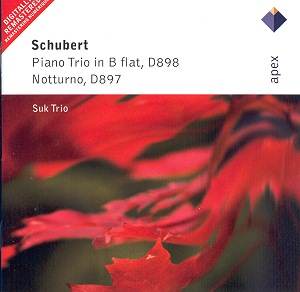‘One glance’ at Schubert’s
piano trios - the bright-voiced, sad-eyed
Biederemeier children of Beethoven’s
Op. 70/Archduke legacy - ‘and
the troubles of our human existence
disappear. All the world is fresh and
bright again’. Thus Schumann.
Thirty, forty years
ago the Suk’s performance of the big-boned
B flat - sublime, Olympian chamber music
- was a yardstick. Here were three great
Czech artists in their prime: Josef
Suk, Joseph Chuchro, Jan Panenka. They
were playing what they’d always breathed,
in familiar surroundings before the
1968 Soviet invasion that, in the BBC’s
words of the time, brought ‘winter to
Prague Spring’. Nowadays, though,
I wonder if their forthright style and
emphatic cheerfulness isn’t just a bit
too much? Granted it helps define and
support the structure. The opening Allegro
(without repeat) gels into a buoyantly
upbeat canter, symphonically Beethovenian,
the hold-backs of tempo comfortably
placed and paced. The finale too coheres
energetically. But briskness can trivialise
and the scherzo comes close to the trite
and charmless. And a reluctance to dwell
can de-mystify. Some expressive yielding
and intensification of accent would
not have gone amiss, for example, in
the ‘shimmering’ subject of the finale
(0:58, 1:40, etc), a passage Frankl-Pauk-Kirshbaum
always used to do so well. More cello
would have been welcome, too, in the
same movement’s 3/2 ‘flat key’ episodes
- a wonderful part especially if the
player risks the slurs, dots and dynamic
hairpins to the full. To miss the long
die-away to the telling triple
piano at bar 607 [7:53] is a
waste of an opportunity.
In Schubart’s ‘key
of love [and] devotion’ (Ideen zu
einer Ästhetik der Tonkunst,
Vienna 1806), the so-called Notturno
– more than probably the B flat’s original
slow movement - persists in the memory.
I’ve long had real affection for it,
unable still to reconcile Jack Westrup’s
stinging 1946 sarcasm: ‘we may be thankful
that this flaccid episode never formed
part of a more substantial work’. The
notion of the piece as ‘atmospheric’
cameo distinct from ‘argued’ canvas
plainly never occurred to him. The Suk
do the music nostalgic justice, drawing-out
and leaning on the dotted-rhythms in
a most Viennese way. They purposefully
co-ordinate the double-dotted-patterns
of the central section with the running
sextuplets of the piano part. This is
fragrant playing.
I like the idea of
this repertory on one disc - however
short value. Programming a ‘first/second
thoughts’ comparison with the 2/2+3/4
Notturno in place of the 6/8
Andante we all know (tracks 1,
5, 3, 4) is a useful listening exercise.
On first hearing the
recording is close and dryish but is
natural in perspective with strings
placed in front of the piano. One soon
gets used to it.
Ateş Orga


